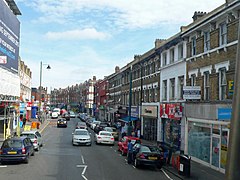West Norwood
| West Norwood | ||
|---|---|---|
| West Norwood High Street | ||
| Coordinates | 51 ° 26 ′ N , 0 ° 6 ′ W | |
| OS National Grid | TQ325715 | |
|
|
||
| administration | ||
| Post town | LONDON | |
| ZIP code section | SE27 | |
| prefix | 020 | |
| Part of the country | England | |
| region | London | |
| London Borough | Lambeth | |
| British Parliament | Dulwich and West Norwood | |
West Norwood is a district of London and is located in the London Borough of Lambeth just under nine kilometers south of central London. West Norwood is bordered to the north by Tulse Hill , to the east by Dulwich , to the southeast by Gipsy Hill and Crystal Palace , to the south by Upper Norwood, and to the west by Streatham . The center of West Norwood lies in a valley surrounded by hills. From there you can see the City of London , Canary Wharf and Crystal Palace. Large areas of West Norwood are residential areas. They mainly consist of two-story row houses in Victorian architecture . Only along the main road are the buildings higher and mixed.
Transport links
West Norwood is connected to the regional road network via Norwood High Street and Knight's Hill (A 215), which runs in north-south direction. The place is well connected to central London by train. The connection is similar to the wagon type and the timetable of a German S-Bahn . A train operated by the Southern operating company stops at West Norwood station about every quarter of an hour and reaches London Victoria Station in about twenty minutes . The nearest London Underground stop in Brixton can be reached by bus from West Norwood. Eight bus routes operate in the district.
Attractions
Most of the sights in West Norwood date from the 19th century:
- The Anglican Church of St. Luke (St Luke's Church) in the classicism style was built from 1822 to 1825 according to plans by the architect Francis Octavius Bedford. The bells of the tower come from the Royal Bell Foundry Vulliamy. In 1892 tubular bells typical of England were added.
- The Cemetery West Norwood is one of seven large cemeteries in the London metropolitan area. The approximately 18-hectare burial site was opened in 1837 and was mainly created for the densely populated, underserved with burial facilities near central London. Numerous graves are lavishly designed in the neo-Gothic style.
- The South London Theater is a stage house that is located in a former fire station from 1881.
- West Norwood Library is housed in an 1888 building and was the first public library in the Lambeth district. It was built according to plans by the architect Sidney RJ Smith, who also designed the Tate Britain .
- Private Bell Museum on Chestnut Road
- Norwood Park Green Area
Education, religion, social issues
West Norwood has five elementary schools and three secondary schools, as well as some private schools. The number of religious communities and parishes has recently risen to around a dozen due to the influx of migrants. Two charities take care of the needy.
history
The name "Norwood" is derived from "Great North Wood", a name for the formerly wooded hills north of Croydon . West Norwood was also known as "Lower Norwood" before 1885. So the name referred to the location in the valley in contrast to Upper Norwood . In 1745 Norwood was almost uninhabited and mostly forested, as can be seen on a map by John Rocque . Only the "Horns Tavern" was already there, which is still today on Knight's Hill opposite the station entrance. By 1800 large areas of Norwood had already been cleared and the first villas with large gardens were built. The land belonged to the Archbishop of Canterbury and Baron Thurlow. The Church of St. Luke was built in 1825 and the cemetery, which is important for Greater London, was opened in 1837. With the completion of the rail link between London and Crystal Palace and Norwood station, intensive urban development began. Many of the country houses have been replaced by more dense buildings. Norwood High Street developed into the center of the district around 1900 with shops and utilities. During the Second World War, numerous buildings were destroyed by bombing raids by the German Air Force , known as The Blitz . Numerous residents died or were left homeless. Chatsworth Church had to be rebuilt. In the post-war period, a number of public housing developments were built in West Norwood. Some of West Norwood's historic quarters and individual buildings are now listed.
Personalities
- Adele (* 1988), singer
- Sir Sidney Colvin (1845–1927), literary and art historian
- Des'ree (* 1968), singer
- Edmund de Waal (* 1964), ceramist and author
- Georg Hackenschmidt (1878–1968), wrestler and weightlifter
- Ken Livingstone (* 1945), politician, former Mayor of London
- Maxi Jazz (* 1957), singer
- Hiram Maxim (1840-1916), inventor
- The Noisettes , music band
- Sandy Nuttgens (* 1964), composer
- Sir John Scarlett (* 1948), former head of the British secret service
- Andrew Turnbull, Baron Turnbull (* 1945), British administrator
literature
- Wilson, JB & Wilson HA: The Story of Norwood, anecdotal and other historical material from the 19th and early 20th centuries , ISBN 0-9515384-1-1





